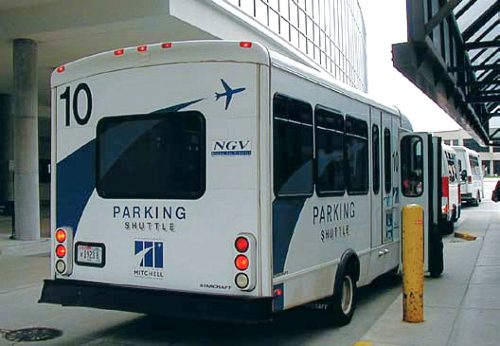 The largest airport in Wisconsin, Milwaukee’s General Mitchell International Airport (MKE), is in the process of converting its shuttles for staff and passengers from diesel-powered Ford cutaways to a similar fleet of compressed natural gas-powered buses.
The largest airport in Wisconsin, Milwaukee’s General Mitchell International Airport (MKE), is in the process of converting its shuttles for staff and passengers from diesel-powered Ford cutaways to a similar fleet of compressed natural gas-powered buses.
The idea to change was sparked in 2000, when the airport updated its master plan. MKE was considering expansion, but also found itself in the 10-county Southeastern Wisconsin moderate ozone nonattainment area, says Greg Failey, environmental manager at MKE. Such an area cannot have ozone levels that exceed National Ambient Air Quality Standards for more than an eight-hour period, according to the Environmental Protection Agency.
The airport consequently replaced two of its 19-passenger diesel shuttles in 2003, and added a third shortly after that. With each shuttle traveling some 40,000 miles per year, switching the three shuttles to compressed natural gas reportedly puts about 3.84 fewer tons of nitrogen oxide, a “greenhouse” gas, into the air annually.
Once the entire fleet is converted, the airport expects emissions to fall by 12.78 tons per year.
“The introduction and use of alternative fuels at General Mitchell International Airport will product long-term benefits of diversified energy sources, compliance with environmental regulations and improved air quality,” says Failey.
Economic Bonus
There was never a question that converting the airport shuttles to compressed natural gas was the right thing to do for the environment. But, saving money in the process was a surprise, says Failey.
Recent record spikes in gas prices have made compressed natural gas much more attractive. In mid-August, local diesel cost $3.80 per gallon vs. $1.70 for compressed natural gas.
Finding a place near the airport to fill the shuttles, however, was originally a hindrance. But last year, MKE partnered with a Clark station less than a mile away to install a pump there. A grant for $500,000 covered 80% of the construction cost for the pumping station, which includes a 20-foot-square enclosure with two fueling stations.
The airport is the primary customer for the station’s compressed natural gas pumps, but they are open to the public, as well. A few vehicles from WE Energies, the local electricity and natural gas utility, and a few vehicles from local plumbing and electrician firms occasionally fill up there, too.
Kanwar Ghuman, a partner in the company that owns the station, reports a lot of interest when other customers see the price of natural gas.
“We get a lot of inquiries about how to change to it,” Ghuman says.
Expanding the Fleet
From an operator’s – and rider’s – perspective, there isn’t any difference between a diesel shuttle and one running on compressed natural gas, says John Moore, manager of parking and ground transportation at MKE.

“They run very smoothly,” he reports.
Moore also gives the vehicles high marks for dependability.
Two more alternative fuel shuttles have already been ordered, and plans are underway to replace the eight others in coming years. About eight maintenance vehicles, both cars and trucks, are also slated for replacement. When the airport increases the size of its shuttle fleet, as it expects to do in the near future, it will be with vehicles that run on compressed natural gas.
The cost of the alternative fuel vehicles is, on average, $8,000 more than traditional vehicles, says Failey.
Depending on the rate of fuel consumption, the difference in cost can be made up in fuel savings in just a few years for a shuttle covering 40,000 miles per year.
“It’s the cleanest burning alternative fuel,” Failey notes. “And it’s significantly cheaper.”
Other Initiatives
Alternative fuel vehicles aren’t the only way MKE is trying to be green, reports Failey.
The airport also redeveloped a 15.2-acre brownfield into remote parking for high-demand travel periods.
Operational airside changes are contributing, too. MKE now uses preconditioned air units and ground electrical power on jet bridges to service aircraft at the gates to decrease the use of jet fuel.
![]()


